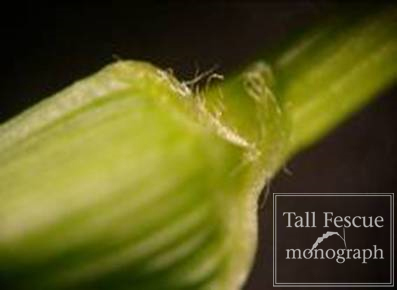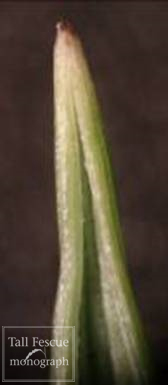Turfgrass professionals must be able to recognize individual species and develop an appropriate management plan. Success in identifying tall fescue depends on being able to locate and describe several vegetative plant parts. A 10X or 15X hand lens can be helpful when looking for small parts that distinguish turfgrasses. The morphological features listed here are used to identify tall fescue.
Auricles: small outgrowths or extensions at the base of a leaf blade located on each side of the collar; auricles of tall fescue may be short and stubby, hairy, blunt, or absent (Fig. 26-1, 26-2).
| Click to Expand | ||||||||
|
Fig. 26-1. Short auricles. (Drawing by G. Dagnan.)
|
 |
|||||||
|
Fig. 26-2. Auricles. (Photo by T. Samples.) |
||||||||
Collar: the area or band of tissue that divides the leaf sheath and blade (Fig. 26-3, shown as a blank area; Fig. 26-4); it is most visible on the backside of each leaf, and in a tall fescue plant it is conspicuous and yellow-green. See the enclosed CD for color versions of the figures.
| Click to Expand | ||||||||
|
Fig. 26-3. Continuous collar. (Drawing, G. Dagnan.)
|
 |
|||||||
|
Fig. 26-4. Collar. (Photo by T. Samples.) |
||||||||
Leaf blade: flattened upper portion of a leaf. The leaf blade of a tall fescue plant is usually medium to dark green, flat, 5 to 12 mm (0.2-0.5 in) wide, strongly veined above, and has rough sandpaper-like margins (Fig. 26-5, 26-6).
| Click to Expand | |||||||
 |
 |
||||||
|
Fig. 26-5. Upper leaf blade. (Photo by T. Samples.) |
Fig. 26-6. Lower leaf blade. (Photo by T. Samples.) |
||||||
Leaf sheath: tubular portion of the leaf below the collar that normally surrounds younger leaves or stem; in tall fescue it is round, smooth, split, and keeled near the top.
Leaf tip: shapes of the leaf tip vary among turfgrass species; in tall fescue the tip is sharply pointed (Fig. 26-7).
| Click to Expand |
 |
|
Fig. 26-7. Leaf blade tip. (Photo by T. Samples.) |
Ligule: outgrowth of the sheath at the inside junction of the leaf sheath and blade projecting upward at the point where the leaf blade angles toward a horizontal plane; the tall fescue ligule is membranous, short, and has a few marginal hairs (Fig. 26-8, 26-9).
| Click to Expand | ||||||||
|
Fig. 26-8. Membranous ligule and split leaf sheath. (Drawing by G. Dagnan.)
|
Fig. 26-9. Ligule. (Photo by T. Samples.) |
|||||||
Rhizome: underground, creeping stem with nodes capable of producing new roots and shoots; a tall fescue plant may have short, thick rhizomes.
Tiller: lateral, aerial shoot that emerges from the crown within a leaf sheath; tillers are primarily responsible for the stand density of tall fescue.
Vernation: arrangement of unexpanded leaves in a bud, determined by cutting across older leaf sheaths or buds and looking inside; leaves of tall fescue have rolled vernation (Fig. 26-10).
| Click to Expand |
|
Fig. 26-10. Rolled vernation. (Drawing by G. Dagnan.) |
| <--Previous | Back to Top | Next--> |